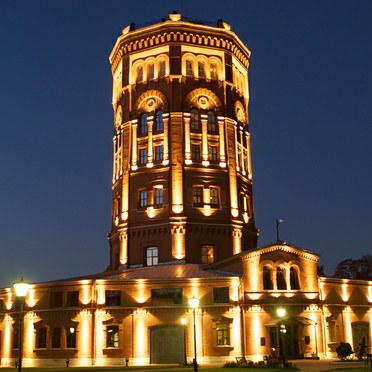Water Museum, St Petersburg, Russia
- Lamp efficacy
Lamp efficacy
Ensuring the lamp efficiently converts electricity into light (lm/W).
- Ballast classification
Ballast classification
Controlling the electricity supply to the lamp (Energy Efficiency Index).
- Luminaire distribution
Luminaire distribution
Controlling light emission using optics which bend and shape the light to the correct location.
- System efficacy
System efficacy
Combining optical and thermal control within the luminaire (luminaire lm/W).
- Presence/absence detection
Presence/absence detection
Providing lighting only when it’s needed.
- Daylight detection
Daylight detection
Reducing waste light during daylight hours.
- Constant illuminance
Constant illuminance
Producing the correct lighting levels for the duration of the maintenance period.
- Task-scene setting
Task-scene setting
Allowing the user to set scenes and adapt the lighting to different tasks.
- Timed off
Timed off
Automatic cut-off to turn all lights off during unoccupied hours.
- Task lighting
Task lighting
Lighting task areas with the correct amount of light.
- Zoning of lighting
Zoning of lighting
Zoning lighting in accordance to occupancy patterns or window location.
- Maintenance schedule
Maintenance schedule
Tailoring maintenance schedules in accordance to product age, performance and environment.
- Waste light
Waste light
Eliminating waste light which does not hit the intended target.
- Reflectance
Reflectance
Taking advantage of light which is reflected from the surface within the space.
- Visible smart metering
Visible smart metering
Enabling results of actions to be quickly seen as increased or decreased energy use to encourage responsible energy consumption.
The illumination of public buildings either by lighting their windows or outlining their main architectural features by means of rows of small lamps is of considerable antiquity. St Peter's in Rome was so lit as long ago as 1650: the basilica was covered with pots of fire, placed so as to emphasize the beauty of its architecture. The technique has persisted in a modified form to the present day although the result it is now less likely to result in an unforeseen fire
A small but effective scheme conducted by Thorn in St Petersburg, for the city's former water-tower, provides an excellent example. Qba floodlights using 70W and 150W high pressure sodium lamps were selected on the grounds that they emphasised the warm tones of the 19th-century brick work and that their compact size and precision beam patterns would facilitate installation and enthral and inspire bystanders whilst limiting obtrusive light.
The tower, which marked the start of the centralised water supply in St Petersburg, was presented to the city by local water company Vodokanal, and now houses a unique Water Museum.
The scheme was designed by SPb GUP "Lensvet". Electrical contractors were LLC "Maltech".

